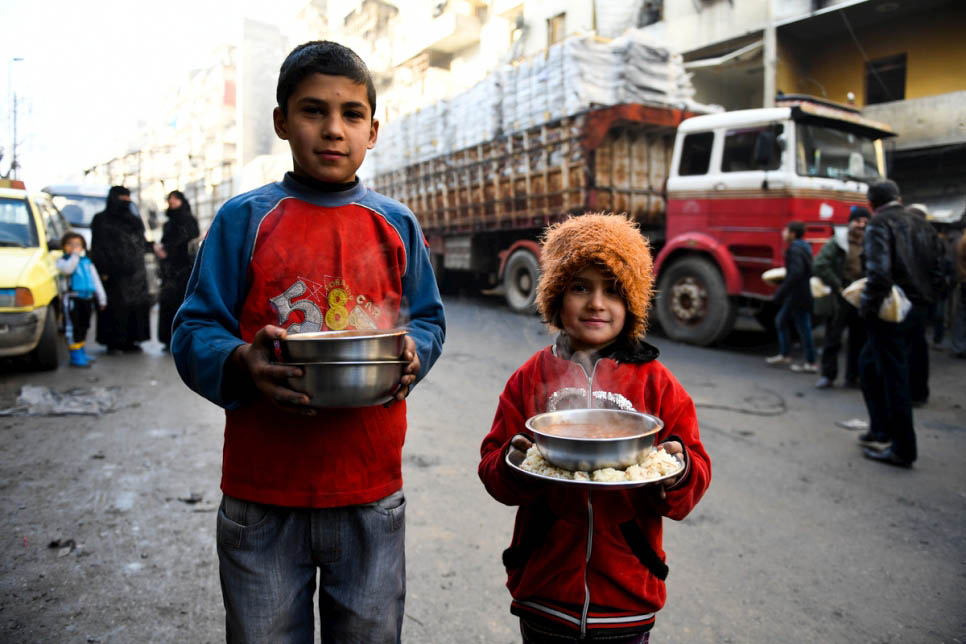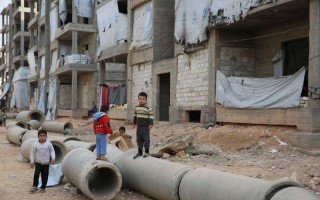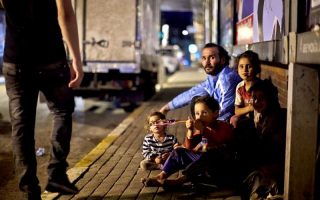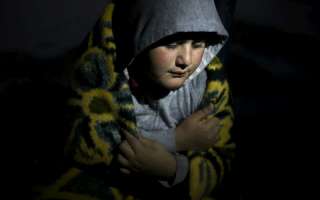Syria Representative Sajjad Malik says 261,000 residents have received winter aid, but needs persist as many shelter in damaged buildings and informal camps.
ALEPPO, Syria– UN agencies are rushing to provide urgent aid to the civilians of Aleppo and are finding fledgling signs of optimism for the future, according to Sajjad Malik, Representative of UNHCR, the UN Refugee Agency, in Syria.

Displaced children carry cooked meals provided by a local charity in the Al-Mashatiyeh neighborhood of east Aleppo, Syria, where UNHCR and its partners are distributing key relief items. © UNHCR/Bassam Diab
Malik has been in the city assessing the needs of its civilians and organizing aid after the siege of the eastern parts of Aleppo ended last month.
“The soul of Aleppo is still there, and there is optimism and there is hope,” said Malik, who is also acting UN Resident and Humanitarian Coordinator in Syria and was speaking Wednesday to a UN news conference from Syria’s second city.
“We need to help people in east Aleppo to at least start rebuilding their lives and livelihoods,” he added.
“We need to help people in east Aleppo to at least start rebuilding their lives and livelihoods.”
The brutal fight for Aleppo, which lasted over four years, ended last month when government-backed forces re-established control over the ancient city, and evacuations of citizens were arranged. There are now tentative hopes that the warring sides will engage in peace talks to bring the broader civil war to a close.
Among the estimated 1.5 million people now in Aleppo, UN agencies have access to about 400,000, the same number that are estimated as displaced in the city. Some families have settled with friends and family. However, many thousands are sheltering in damaged buildings or informal settlements.
UNHCR, other UN agencies and partners have been focusing on immediate assistance. The priorities are shelter, food, fuel, winter clothing, water and sanitation, medical support and civilian protection for a population scarred by years of conflict.
The UN currently has just over 100 staff in Aleppo, working with partners including the International Committee of the Red Cross and the Syrian Arab Red Crescent, as well as Syrian NGOs and local authorities.
A small part of Aleppo still lacks access to aid, primarily due to the presence of unexploded ordnance, and support is urgently required to help safely remove these hazards.
Malik said that children had started to re-emerge on the streets and residents were tentatively talking about rebuilding their livelihoods. “We need to invest in this optimism and hope of Syrians — the resilient people there — we need to give peace a chance,” he added. “The last four, five days have already made a huge difference.”
Since last month, access to safe water for 1.1 million people has been restored through the installation of storage tanks and by repairing water networks.
Given the bitter winter conditions, another focus has been warmth. Over 261,000 people have received aid via the distribution of blankets, mattresses, winter clothes, insulation kits, family tents, carpets, sleeping bags and jerry cans. Much more is needed to help weather the freezing conditions, Malik said.
Seven UN mobile clinics and 12 mobile teams are providing health services, and 70 tons of pre-positioned medical supplies are available for 300,000 treatment courses in underserved areas. In addition, almost 10,500 children have been vaccinated against polio, and 1,381 critically ill and wounded from east Aleppo have been referred to public hospitals. Tens of thousands have received hygiene kits.
Food rations have been rushed in, covering 119,500 people for one month. Communal kitchens have been established to provide hot meals for 20,700 in collective shelters. The UN is distributing freshly baked bread daily for 40,000.
“We need to invest in this optimism and hope … to give peace a chance.”
Cases of unaccompanied and separated children have been identified by the UN and are receiving follow-up care. Prefabricated classrooms are also being erected for displaced children, and education materials brought in. Ultimately, UNHCR and its partners aim to help fully restore all education facilities destroyed across Aleppo.
“There’s a lot more that we still need to do,” Malik added. “We need to keep building on this.”
The UN is working with municipalities to remove debris from several neighbourhoods and pumping stations; 115 displaced people have joined UN workshops on basic infrastructure rehabilitation, and this model will be used in several districts.
Further out, a comprehensive approach to reconstruction is needed. Here, planning remains formative, with the broader conflict still ongoing. There will be a need for heavy machinery and engineers. In the meantime, the UN has been assessing the reconstruction task and will soon present donors with findings and funding requirements.
“Over the last few days that I have been going in and out of east Aleppo with the team we can see the difference that this project is making in clearing up the main roads,” Malik said. “People are coming back and just beginning to say, ‘how do we rebuild our lives?’”
Malik stressed that while the battle of Aleppo is over, there remains a massive humanitarian need across the country. The conflict has forced 4.86 million Syrians into neighbouring countries, while 13.5 million inside the country rely on humanitarian aid, with 6.3 million internally displaced. UN agencies and NGO partners have appealed for more than USD 4.69 billion for a 2017 regional support plan.
In a statement last month, the UN High Commissioner for Refugees Filippo Grandi said there was still a “grave risk” that displacement and suffering would not stop at Aleppo, but would be repeated in other wars. “For the sake of civilian protection everywhere, Syria’s conflict must be ended, now, and without delay,” he said.
Writing by Matthew Saltmarsh in Geneva.
Article originally posted on unhcr.org





